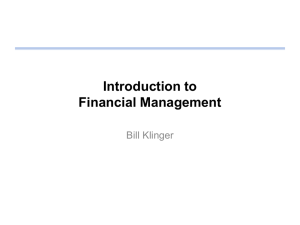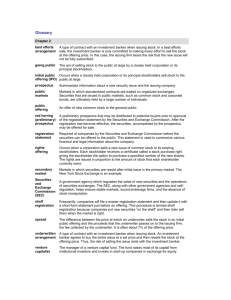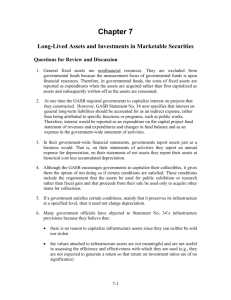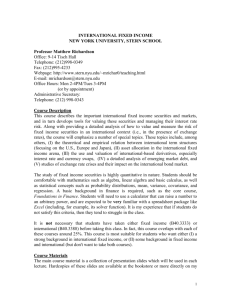shelf markets
advertisement
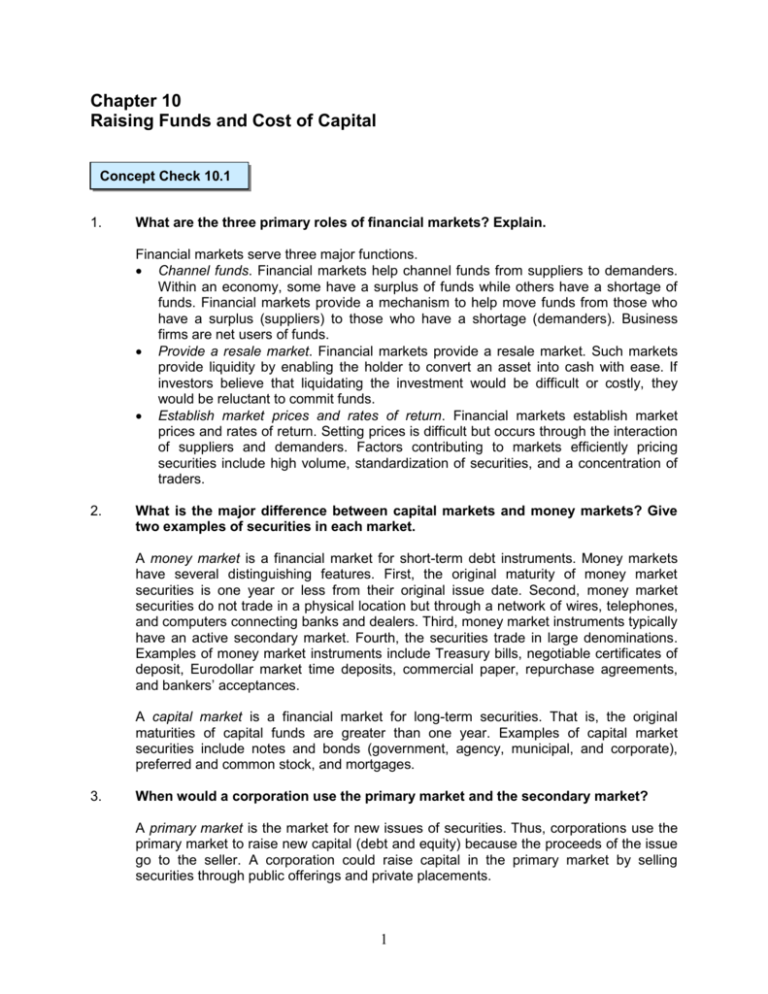
Chapter 10 Raising Funds and Cost of Capital Concept Check 10.1 1. What are the three primary roles of financial markets? Explain. Financial markets serve three major functions. Channel funds. Financial markets help channel funds from suppliers to demanders. Within an economy, some have a surplus of funds while others have a shortage of funds. Financial markets provide a mechanism to help move funds from those who have a surplus (suppliers) to those who have a shortage (demanders). Business firms are net users of funds. Provide a resale market. Financial markets provide a resale market. Such markets provide liquidity by enabling the holder to convert an asset into cash with ease. If investors believe that liquidating the investment would be difficult or costly, they would be reluctant to commit funds. Establish market prices and rates of return. Financial markets establish market prices and rates of return. Setting prices is difficult but occurs through the interaction of suppliers and demanders. Factors contributing to markets efficiently pricing securities include high volume, standardization of securities, and a concentration of traders. 2. What is the major difference between capital markets and money markets? Give two examples of securities in each market. A money market is a financial market for short-term debt instruments. Money markets have several distinguishing features. First, the original maturity of money market securities is one year or less from their original issue date. Second, money market securities do not trade in a physical location but through a network of wires, telephones, and computers connecting banks and dealers. Third, money market instruments typically have an active secondary market. Fourth, the securities trade in large denominations. Examples of money market instruments include Treasury bills, negotiable certificates of deposit, Eurodollar market time deposits, commercial paper, repurchase agreements, and bankers’ acceptances. A capital market is a financial market for long-term securities. That is, the original maturities of capital funds are greater than one year. Examples of capital market securities include notes and bonds (government, agency, municipal, and corporate), preferred and common stock, and mortgages. 3. When would a corporation use the primary market and the secondary market? A primary market is the market for new issues of securities. Thus, corporations use the primary market to raise new capital (debt and equity) because the proceeds of the issue go to the seller. A corporation could raise capital in the primary market by selling securities through public offerings and private placements. 1 A secondary market is the market for buying and selling securities subsequent to original issuance. Because secondary markets are resale markets, firms do not use secondary markets to raise new capital. The proceeds of secondary market sales accrue to the selling dealers and investors, not to the firms originally issuing the securities. Corporations are interested in the secondary market on which their securities trade because a healthy secondary market may help to entice investors to buy their new stocks or bonds. In addition, corporations use the secondary market to repurchase their securities or buy securities in other companies. 4. How do primary markets differ from secondary markets? A primary market is a financial market for the original sale of new securities, whereas a secondary market is a market for trading existing securities among investors. In the primary market, the issuer receives the funds raised by the initial sale. The original issuer does not receive the proceeds of a secondary market sale. Concept Check 10.2 1. What are the major functions of financial intermediaries? Explain. The major function of financial intermediaries is to facilitate the transfer of financial assets and obligations between various market participants. The main market participants are savers (suppliers) and users (demanders) of funds. Other functions of intermediaries depend on their classification – depository institutions and nondepository institutions. Depository institutions accept depositions that customers can redeem on demand. Two major types of depository institutions are commercial banks and thrift institutions such as savings and loan associations, mutual savings associations, and credit unions. For example, some activities of banks include extending credit, servicing loans, offering trust operations, and providing investment advice. Nondepository institutions accept funds for investment, but typically do not provide check-writing privileges. Nondepository institutions include insurance companies, brokerage firms, investment companies, and pension funds. 2. What are the three major functions of investment bankers involving a new security issue? An investment banker is a firm that serves as a financial intermediary between an issuer of securities and the investing public. Although investment bankers perform a wide variety of services, the three most important services are underwriting, marketing, and advising. Underwriting. The chief function of investment bankers is underwriting securities issues. They assume the risk of buying securities from issuers and reselling them to the public in the primary market. Marketing. Related to underwriting is marketing an issue. The investment banker forms an underwriting group or syndicate to spread the risk and a selling group, consisting of dealers and underwriters, to assist in distributing the issue. Investment bankers sometimes do not underwrite an issue but sell the new security directly to one or more purchasers through a private placement or sell the security issues to the 2 3. public without taking on the risk of underwriting by using a best efforts basis. Investment bankers also handle these marketing functions. Advising. Investment bankers perform the role of advising clients. That is, the investment banker acts as a consultant. For example, an investment banker may advise a client about the appropriate means of financing and provide advice about mergers and other corporate reorganizations. Why would an investment banking firm form an underwriting syndicate instead of keeping all the business and profits for itself? An underwriter agrees to buy securities for resale to investors and bears the risk of selling these new securities. Forming an underwriting group or syndicate provides a way to spread the risk among an association of commercial banks and investment banks that buy a new offering of securities. The group signs an underwriting agreement with the issuer that specifies the terms of the proposed offering and the amount that each member of the group agrees to buy. Having an underwriting group also helps to assure successful distribution of the issue. Concept Check 10.3 1. How does a corporation? privately held corporation differ from a publicly held A privately or closely held corporation is typically a small firm in which only a few individuals hold its stock. Often, the stockowners manage the firm. The stock of privately held companies rarely sells so a market price is unavailable. A publicly held corporation has shares available to the public at large. Investors holding its shares typically do not actively manage the firm, but instead hire professional managers as their agents. A secondary market exists for the shares of publicly held stock. 2. What are the advantages and disadvantages of going public? Going public offers a host of advantages and disadvantages. Advantages. The advantages of going public include increasing access to capital, increasing liquidity of the firm’s stock, providing a market value for the firm’s shares, and enabling the firm to attract managers and other talented employees. Disadvantages. The disadvantages of going public include diluting control and autonomy of the original owners, increasing reporting costs, requiring public disclosure of operating data, and possibly having little public trading of the firm’s stock. 3. What are several explanations for the underpricing of IPOs? Determining the appropriate offering price for an IPO is difficult for the lead investment bank. The issuer faces a potential cost if the investment banker sets the cost too high or too low. If the price is too high, the issue may be unsuccessful and withdrawn. If the price is too low, the issuer “leaves money on the table” and experiences an opportunity loss. Several possible explanations exist for underpricing. 3 Asymmetric information hypothesis. This explanation asserts that IPO underpricing results from differences in information between parties about the value of the new issue. Risk-aversion underwriter’s hypothesis. This view maintains that investment bankers intentionally underprice new common stocks to reduce their risks and costs of underwriting. Insurance hypothesis. According to this explanation, investment bankers underprice unseasoned issues as a form of insurance against legal liability and the associated damage to the reputation of the investment banker. Fads or speculative-bubbles hypothesis. This view states that IPOs are subject to overvaluation or fads in early aftermarket trading. Regulatory and procedural hypothesis. This explanation suggests that regulations and procedures governing the underwriting and pricing of IPOs encourage underwriters to underprice new issues. Concept Check 10.4 1. What is the difference between a competitive bid and a negotiated offer? An issuer may select an investment bank through competitive bidding or a negotiated offering. Under a competitive bid, a prospective underwriter submits a sealed bid containing the price and terms for a specific issue. The issuer awards the contract to the bidder with the best price and terms. Under a negotiated offer, the issuer hires an investment banker for a new security issue. The issuer and underwriter determine the spread between the purchase price paid to the issuer and the public offering price through negotiation instead of competitive bidding. The spread represents compensation to the investment bankers participating in the underwriting. New issues of public utilities holding companies require competitive bidding. Most industrial companies prefer to negotiate with their investment bankers on stock and bond issues. 2. How does the risk differ to an investment banker who sells new securities with a firm commitment underwriting versus a best-efforts agreement? A firm commitment underwriting is an arrangement whereby an investment bank or a group of investment banks buys new securities from an issuer that it will later offer to the public. The difference between the proceeds an issuer receives and the price paid by the public for the issue represents the underwriting spread. Because the underwriter guarantees the issuer a specific amount from the issue, it bears the risk of price changes between the time of purchase and the time of sale. If the underwriter cannot sell all of the issue at the agreed-upon price, it may need to lower the price on the unsold shares. Today, the practice of outright buying of a securities issue by investment bankers is commonplace. A best-efforts agreement is an arrangement whereby investment bankers agree to do their best to sell an issue to the public. Because investment bankers are acting as agents, they avoid the risk associated with underwriting because they do buy the 4 securities. Firms specializing in speculative securities of new and unseasoned companies often handle best efforts deals. 3. What are the benefits of using a shelf-registration when issuing new securities? A shelf-registration is a term used for Securities and Exchange Commission (SEC) Rule 415, which allows a corporation to comply with registration requirements up to two years before a public offering of securities. The corporation must file the required annual, quarterly, and related reports to the SEC. A shelf-registration allows a corporation to go to market quickly when conditions become favorable with a minimum of administrative preparation. Thus, the flexibility of a shelf registration results in considerable savings of time and expense as well as less risk that the shares will drop between the period of announcement and time of the issue. Note: In late 2004, the SEC proposed technical changes designed to modernize the shelf registration process. One proposal was to replace the current requirement that a company may register only the amount of securities it intends to offer within two years with a new requirement that the company would update its registration statement with a new one every three years. Concept Check 10.5 1. How do general cash offers differ from rights offers? A cash offer is the sale of a public issue to all interested investors. Two basic methods of issuing securities for cash are the firm commitment underwriting and a best-efforts agreement. A rights offer involves offering common stock to existing shareholders who hold rights that entitle them to buy newly issued shares at a discount from the price that the firm or investment banker later offers the shares to the public. Investment bankers handle most rights offerings under a standby commitment, whereby the investment bankers agree to buy any shares not subscribed to by the holders of rights. 2. What are the basic steps in selling a new issue? Explain. The process of selling a new issue involves a logical sequence of events. Making preliminary decisions. A firm decides that it needs additional financing through the capital markets and makes some preliminary decisions about the amount of capital needed, the type of securities to use, and the timing of the issue. Selecting an investment banker. The issuer chooses an investment banker. This selection process can be through a negotiated offering in which the issuer hires the investment banker or competitive bidding in which the issuer awards the issue to the investment banker that bids the highest price. Conducting conferences with the issuer. The investment banker and issuer hold a series of pre-underwriting conferences to reevaluate the firm's preliminary decisions involving the issue. The investment banker also examines the financial position of the firm and the uses of the funds that the firm plans to raise. 5 3. Deciding the method of raising capital. An output of these meetings is the determination of the amount of capital the firm plans to raise and its form. At this point, the parties draw up a tentative underwriting agreement. Syndicating the underwriting. For large offerings, the underwriter forms an underwriting syndicate to spread the risk of adverse price movements among a group of investment banking firms. Each underwriter in the syndicate is responsible for selling a specific portion of the issue. Forming a selling group. The syndicate manager appoints a group of dealers to market the issue to the public. Each member of this group, called the selling group or syndicate, is responsible for selling a certain portion of the issue. The selling group may or may not have the obligation of buying unsold shares. Registering the issue. The issuing firm must fulfill various legal requirements. Working with the underwriter, the issuer prepares and files a registration statement with the Securities and Exchange Commission (SEC). Part of the registration statement is the prospectus, which sets forth the plan for funds and details the firm’s operating and financial position. The SEC must approve the registration statement, a procedure usually requiring 20 days, before the issuer can sell a new security. Pricing the issue. The underwriting syndicate usually waits until the end of the registration period to set an offering price. Selling the issue. After the SEC approves the registration statement, publicizing the issue occurs. The underwriter places the security on the market and then accepts orders. The underwriting syndicate may attempt to stabilize the price in order to sell the entire issue at or near the initial offering price. This process, called market stabilization, occurs when the underwriting syndicate places orders to buy the security it is trying to sell to keep the demand for the issue. Dissolving the syndicate. The syndication ends after selling the issue and turning the net proceeds over to the issuer. Why might a firm prefer to use a rights offer to a general cash offer? A rights offer has several advantages over a general cash offer. Retains proportionate ownership. Under a rights offer, existing owners have the right to maintain their proportional ownership. Because of separation of ownership and control, this probably benefits only shareholders with large holdings. Nonetheless, this advantage may increase loyalty of existing stockholders. Today, smaller companies tend to use stock rights to avoid dilution of ownership, which is the risk that shareholders may lose their proportionate control of the corporation. Rights offers are infrequent in the United States, but commonplace elsewhere. Protects against loss of wealth. A rights offer protects existing shareholders from a potential loss of wealth that can result from a public offering. Because the investment banker offers new shares at a price below the current market value, this inducement transfers wealth from existing shareholders to new shareholders. A rights offer avoids this wealth transfer because existing shareholder receive this benefit if they sell or exercise their rights. Concentrates the focus of sale. Unlike a general cash offer, a rights offer enables a firm to concentrate its selling efforts on investors who already own shares. This benefit is especially important to a firm that has concentrated stock ownership and lacks a broad market appeal for its stock. Entails lower issuance costs. From the firm's perspective, rights offers are usually cheaper than cash offers because a rights offering can involve negligible 6 underwriting risk and selling effort. Thus, the flotation cost is minimal, especially if the underpricing is substantial. Provides flexibility. Rights offerings enable the issuing firm to make the offer directly to shareholders or through an investment banker. Concept Check 10.6 1. Who are some typical buyers of securities through a private placement? Most private placements involve debt, but firms can use private placements for any type of security. Typical buyers of securities through a private placement tend to be large institutions with plenty of cash such as insurance companies, pension funds, commercial banks, and mutual funds. In addition, corporations can directly place common stock to managers through stock options, to employees through stock-purchase plans, and to existing shareholders through rights offering. 2. Why might a firm use a private placement instead of a public offering? A private placement is the sale of securities or other investments directly to a limited number of buyers. A firm may chose a private placement instead of a public offering for several reasons. Greater flexibility. The issuer of a private placement has more flexibility in tailoring covenants and renegotiating them than with a public offering. In the private market, the issuer has greater flexibility of issue size in being able to offer smaller issues. Speed of issuance. Firms that do not qualify for shelf registration can place issues more quickly because they do not have to file registration statements or obtain the approval of the SEC. Lower flotation costs. Private placement may reduce administrative and issuance costs, especially for smaller issues. Private placement often involves less expense to the issuer who can avoid underwriting fees, sales commissions, and registration expenses. The Securities and Exchange Commission (SEC) imposed costly rules on publicly issued securities. Privacy. A private offering avoids public disclosure of the firm’s business plans. The SEC requires considerable disclosure in public offerings. 3. What are some potential disadvantages to the issuer of using a private placement? Private placements have the following disadvantages relative to public offerings. Higher interest and dividend rates. Due to their lack of liquidity, investors demand a premium for private placements. Thus, private placements tend to be more expensive than general cash offers. Lower demand. Private placements must satisfy certain requirements for exemption from registration. These requirements limit the investors who are eligible to buy unregistered securities and reduce demand for these securities. Less liquidity. Because securities laws place substantial restrictions on resale of privately placed securities, this reduces their liquidity. Investors require a higher return to compensate for increased liquidity risk. 7 More restrictions. Private purchasers and lenders require more restrictive terms and tighter covenants to protect themselves against adverse actions that the issuer might take. Concept Check 10.7 1. What types of costs do corporations incur when issuing new securities? Corporations incur several types of costs when issuing securities. Flotation costs are the total costs of issuing and selling a security. Flotation costs consist of two main elements: (1) the underwriting spread, which is the key variable in flotation costs, and (2) other direct expenses to the issue. The underwriting spread is the dollar difference between the amount the underwriting group pays for a new issue of securities and the price at which this group offers the securities for sale to the public. This spread consists of the management fee, underwriting fee, and selling concession. Other expenses to the issuers include fees for lawyers and accountants as well as the costs of printing, engraving, and mailing. These costs typically represent fixed expenses because the size of the issue has little effect on them. An issuer also incurs indirect costs. For example, the market price of a security may decline upon the announcement of the offering. Underpricing of an IPO is also an indirect cost. 2. What are three factors that affect flotation costs? Although various factors affect flotation costs, three of the most important are the: (1) type of security, (2) riskiness of an issue, and (3) size of an issue. Type of security. Research evidence reveals that flotation costs are higher for stocks than for bonds. This relationship reflects the wider distribution and greater volatility of common stock compared with bonds. Firms typically sell bonds in large blocks to relatively few investors. Riskiness of an issue. Selling stock is typically more risky than selling bonds and thus results in higher flotation costs compared to bonds. Size of an issue. Flotation costs as a percentage of gross proceeds are greater for smaller issues than for larger ones. This occurs because the issuer’s legal and other expenses are generally large and fixed. In addition, less established firms tend to have smaller issues, which requires more information development and marketing expense. Concept Check 10.8 1. What is the meaning of cost of capital and weighted average cost of capital? The cost of capital is the required rate of rate for suppliers of funds. Thus, cost of capital is an opportunity cost. A firm must earn this rate on capital investment to maintain its 8 market value and to attract funds. The weighted average cost of capital (WACC) is the expected overall cost of a firm’s permanent financing, which consists of the cost of a firm’s debt and equity. Thus, the WACC is the required rate of return for the firm as a whole. Estimating the WACC involves multiplying the weight of each capital component in a firm’s capital structure by its component cost. 2. What factors affecting a firm’s cost of capital are beyond its direct control? Various factors affect a firm’s cost of capital that are beyond its direct control. These factors generally relate to market conditions including the level of interest rates, tax rates, and the market risk premium. 3. What are two major uses of the cost of capital? Explain. Two major ways that managers and analysts use estimates of the firm’s cost of capital are: (1) to help identify the discount rate to use when analyzing proposed capital investments and (2) to serve as a guideline in developing capital structure and evaluating financial alternatives. Use as a discount rate. The financial goal of the firm is shareholder wealth maximization. To create wealth, firms must undertake capital investments whose benefits exceed their costs in a present value sense. Using the cost of capital as a discount rate provides the basis for evaluating whether long-term projects increase or decrease shareholder wealth. A firm must earn at least its cost of capital (WACC) to maintain the market value of its stock. Use to evaluate the capital structure. Another use of the cost of capital is to determine whether the firm’s capital structure is optimal. That is, the financial manager strives to find the correct mix of debt and equity that gives the lowest overall cost of financing. By finding the optimal capital structure, the financial manager minimizes the firm’s WACC and maximizes its value as measure by the stock price. Thus, the financial manager can estimate the effects of altering the firm’s mix of debt and equity upon its WACC and value. 4. What is the primary determinant of the cost of capital (appropriate discount rate) for an investment? The primary determinant of the cost of capital is the use of the funds, not the source of financing for a capital budgeting project. Evaluating an investment using the cost of funds that the firm will use to finance a particular investment is a mistake. Firms usually raise money in a lumpy manner, but the cost of capital should reflect the interrelatedness of financing activities. Otherwise, managers may accept poor projects before better ones become available. To reflect the interrelatedness of financing sources, firms should use an overall cost of capital, not the cost of the specific source of funds used to finance a given project. In addition, more risky projects require a higher return than do less risky ones to compensate the providers of funds. Thus, the cost of capital (required rate of return or discount rate) should reflect the riskiness of the project. 5. Why should corporate managers measure the cost of capital on an after-tax cost of capital? Corporate managers should measure all component costs, and hence the overall cost of capital, on an after-tax basis to be consistent and to reflect the true cost of capital to the 9 firm. In the United States, the only component costs requiring an adjustment to an aftertax basis is debt. The current market interest rate is not the true cost of debt to the company. Interest on debt is a tax-deductible expense. The tax deductibility of debt reduces the cost of debt because the government picks up a portion of the debt expense by reducing the taxes owed by the firm. Dividends on preferred and common stock are not tax deductible so these two cost components are already on an after-tax basis. That is, firms pay preferred and common stock dividends from after-tax income, requiring no tax adjustment. 6. Is the historical cost of capital or the marginal cost of capital more meaningful for making financial decisions? Explain why. The historical cost of capital is irrelevant for purposes of making financial decisions because the firm has already raised and used the funds. The more meaningful cost for making financial decisions is the WACC, which refers to the next dollar of total new financing. Thus, WACC is the marginal cost for raising additional capital averaged across the different sources. Firms use the cost of capital primarily to make decisions involving financing and investing decisions. Therefore, the relevant cost is the marginal cost of any incremental funds that the firm plans to raise during the planning period. 7. What are two ways of treating flotation costs? Flotation costs are the fees and expenses a firm incurs issuing securities. There are two major ways of treating flotation costs. Regardless of the treatment, flotation costs are a relevant cost when making public offerings of debt and equity. Adjust component cost. One way of treating flotation costs is to adjust the component costs upward to reflect flotation costs. This approach increases both the firm’s WACC and the discount rate that managers use for capital budgeting projects. Financial managers usually prefer this approach. Adjust cash flows. Another approach is to treat flotation costs as an additional outflow that increases the initial cash outlay of an investment. Concept Check 10.9 1. Why does the impact of a given flotation cost on the specific cost of bonds depend on the maturity of the debt? In general, the higher the flotation costs, the higher will be the specific cost of capital because flotation costs lower the net proceeds to the firm. Unlike preferred and common stock, bonds have a maturity date. The maturity of the debt affects the impact of a given flotation cost on the cost of bonds. Generally, the impact on the cost of debt decreases as the number of years to maturity increases. Why does this occur? For purposes of simplicity, suppose a bond has a face value of $1,000 and pays a 7% annual coupon. If flotation costs are 2%, the firm receives net proceeds of $980 for each bond sold. When the bond matures, however, the firm must pay $1,000. Thus, the spread on the cost of the debt component (the difference between the face value and net proceeds) is $20. The greater the number of years to maturity (say 20 years compared with 5 years), the smaller is the impact of a given spread on the cost of debt. The yield to maturity (YTM), which is the annualized percentage return of a bond held until its stated maturity, would 10 be 7.19% for the 20-year bond compared with 7.49% for the 5-year bond. Multiplying the YTM by (1 – tax rate) would provide the after-tax cost of debt. 2. Why is estimating the cost of common equity more difficult than estimating the cost of debt or preferred stock? Estimating the cost of common equity is more difficult than finding the cost of either debt or preferred. Because straight debt and most preferred stock (a notable exception is noncumulative preferred stocks) represent a contractual obligation to make specific payments, the stream of cash flows is highly predictable. No such assurances exist for common equity. Paying dividends rests with the discretion of the board of directors. Thus, there is no contractual fixed dividend stream with common stock. Nonetheless, equity has an opportunity cost based on returns that investors expect from investments of equal risk. Because of the uncertainty associated with the cost of equity, several methods are available to compute its cost. 3. What are the advantages and disadvantages of the three methods used to estimate the cost of existing equity? The cost of exiting equity is the opportunity cost of funds of the firm’s shareholders. Various methods are available to estimate the cost of existing equity because analysts cannot directly observe the return investors are expecting from investments of similar risk. Three models available to estimate the cost of existing equity are the: (1) capital asset pricing model (CAPM), (2) dividend discount model, and (3) bond-yield-plus-riskpremium approach. Each method has advantages and disadvantages. The CAPM Advantages: The CAPM offers the advantage of directly considering risk as reflected by beta to determine the required return. Second, the CAPM has a strong theoretical foundation. Finally, the CAPM is applicable to companies whether they pay dividends or not. Disadvantages: A major drawback of the CAPM is the difficulty of estimating the model’s inputs (the risk-free rate, beta, and the market return). Some inputs are difficult or impossible to estimate accurately. Another disadvantage is the reliance on past data to predict the future. The past may give clues of the future but the risk of the firm may change. That is, the sensitivity of a firm’s stock returns may change over time. Thus, analysts may need to adjust the historical beta to reflect anticipated changes. Third, the CAPM assumes than investors hold diversified portfolios and thus the only relevant risk is market risk. If investors are not fully diversified, using this method may understate their required return and hence the cost of common equity. Finally, if a firm’s stock does not trade publicly, no historical data would be available for values needed in the model. Dividend discount model Advantages: An advantage of this model is its relative simplicity if dividends are constant forever. In addition, the data required for the constant growth model are readily available. Analysts can easily adjust for flotation costs if they desire is to find the cost of new common stock, not the cost of existing equity. Disadvantages: First, substantial difficulty exists in predicting the dividend stream and the growth rate. Common stock dividends do not typically remain constant. Some companies do not currently pay dividends while others have erratic growth. 11 Thus, the constant growth model may be appropriate to use to estimate the cost of equity for firms with stable dividend policies, but it is unlikely to be applicable to all firms. Second, this approach does not explicitly consider risk. Instead, the model uses the market price to reflect the expected risk-return preference of investors in the marketplace. 4. Bond-yield-plus-risk-premium approach Advantages: An advantage of this method is that it produces a “ballpark” estimate of the cost of existing equity. Another advantage is the reasoning that a firm’s cost of equity should be higher than its long-term debt. Third, for publicly traded bonds, analysts can compute bond yields with a reasonable degree of accuracy. Thus, the task is to determine the appropriate risk premium. Disadvantages: This approach does not provide an exact estimate of the cost of existing equity because the equity risk premium is often a judgmental estimate. This premium can differ greatly depending on the method and estimation period used to calculate the premium. What are three approaches for estimating the growth rate of dividends for the dividend discount model? What are their advantages and disadvantages? Several approaches are available for estimating the growth rate of dividends (g) using the dividend growth model. Three methods are: (1) historical time series method, (2) sustainable growth method, and (3) analysts’ forecasts method. These approaches typically provide different growth rates. Historical time series. This method estimates the growth rate based on historical data on earnings and dividends. Advantages: The growth rate using this method is easy to calculate. Disadvantages: The historical growth rate is seldom steady. This approach fails to consider the riskiness surrounding the estimated growth rate. Different growth rates typically result depending on whether the analysts use the arithmetic or geometric mean. Sustainable growth method. The basis of this approach to estimating the dividend growth rate is the retention rate (RR) and the return on equity (ROE). Advantages: Calculating the growth rate is simple once identifying the two inputs. Thus, g = RR (ROE). Disadvantages. Several assumptions underlie this approach: (1) the retention rate is constant and the return on equity is stable; (2) the firm does not plan to issue new common stock; and (3) the degree of risk of future projects remains the same as the firm’s existing assets. In practice, firms may violate these assumptions. For example, some companies do not currently pay dividends. For other firms paying dividends, growth is erratic. Analysts’ forecast method. Some managers use surveys of security analysts or published forecasts such as those in Value Line to estimate the growth rate. Advantages: Published forecasts are readily available. Disadvantages: Security analysts often vary in their estimates of future growth. Thus, determining the most accurate expected growth rate is difficulty. 5. What effect do flotation costs have on the cost of capital components? 12 Flotation costs are the total costs of issuing and selling new securities. Flotation costs reduce the net proceeds to the firm and thus increase the specific cost of the capital raised. Concept Check 10.10 1. What are the steps in calculating the weighted average cost of capital? Finding the weighted average cost of capital (WACC), which represents a single cost of capital for a firm, involves multiplying each cost component by the proportion or weight it occupies in the capital structure. The sum of the weights must equal 100% or 1.0 if the weights are in decimal form. Calculating WACC involves three steps: (1) estimating each component cost, (2) determining the weight of each capital component in the firm capital structure, and (3) multiplying each component cost by its appropriate weight. 2. What are three types average cost of capital? of weights available to calculate the weighted Three common weighting schemes available to compute WACC are: (1) book value weights, (2) market value weights, and (3) target weights. Book value weights use accounting values shown in the firm’s balance sheet to measure the proportion of each type of capital in the firm’s capital structure. Market value weights measure the proportion of each type of capital based on its current market value. Target value weights measure the proportion of debt, equity, and preferred stock in the firm’s target mix. The target mix is management’s desired capital structure proportions that result in the lowest average cost of funds. Managers may express target weights in term of either market or book values. 3. Which type of weight is most appropriate? Why? The theoretically more accurate approach is to use a weighting scheme based on target market value proportions. Target weights are preferable because WACC is the rate used to evaluate long-term projects. Over time, a firm should achieve its targets of how it wants to raise money in the future. In some instances, analysts could use book values to calculate the target weights if no substantial changes have occurred in surety prices. If target weights are unavailable, analysts may substitute other methods. A clear preference exists for using market value weights over book value weights. Concept Check 10.11 1. How does the marginal average cost of capital? cost of capital differ from the weighted As a firm raises more money, the cost of each additional dollar of new capital may increase because of greater risk and higher flotation costs. The marginal cost of capital 13 (MCC) is the cost of the last dollar of new capital raised. If a firm uses more than one type of new financing, the MCC represents a weighted average cost of the last dollar of capital raised, reflecting higher marginal costs. A firm’s weighted average cost of capital (WACC) equals its MCC until the cost of a capital component increases. 2. What are the steps in developing the MCC schedule? The marginal cost of capital (MCC) schedule shows the cost of capital as the firm raises additional dollars. Developing the MCC involves five steps: determine the appropriate weights of the new financing; calculate the component cost of capital associated with each amount of capital raised; calculate the range of total new financing at which the cost of the new components change; calculate the MCC for each range of total new financing; and plot the MCC schedule. 3. Why do break points occur in the MCC schedule? A break point is the point where the cost of capital increases. A break point reflects the level of total new financing at which the cost of one of the financing components rises. Thus, the firm’s marginal cost of capital shifts upward on the MCC schedule at the break point. 4. What is the formula for calculating break points? The formula for finding break points is BPi = TFi/wi. In this equation, BPi is the break point for capital component i; TFi is the total amount of funds available from capital component i at a given cost; and wi is the capital structure weight (stated in decimal form) for capital component i. 5. How does a firm determine its optimal capital budget? To maximize shareholder wealth, managers must invest in a project until the marginal cost of capital is equal to its marginal benefits. An optimal capital budget is the level of capital expenditure at which the marginal cost of capital (MCC) schedule intersects the investment opportunity (IOS) schedule. Determining the intersection point involves plotting both the MCC schedule in conjunction with its available IOS schedule, with projects in descending order according to their internal rate of return (IRR). By combining the firm’s IOS and MCC schedule, managers can determine the firm’s optimal capital budget and identify the cost of capital they should use to evaluate average-risk capital budgeting projects. 14
